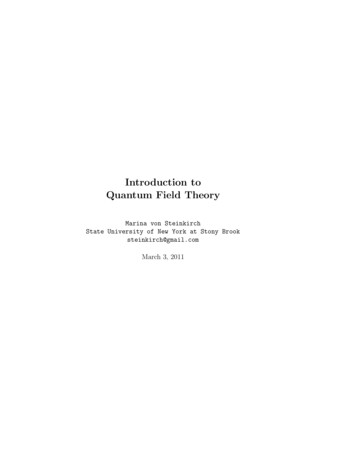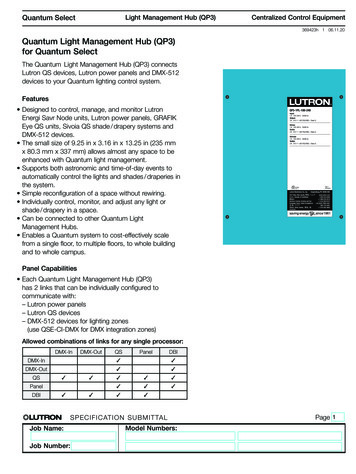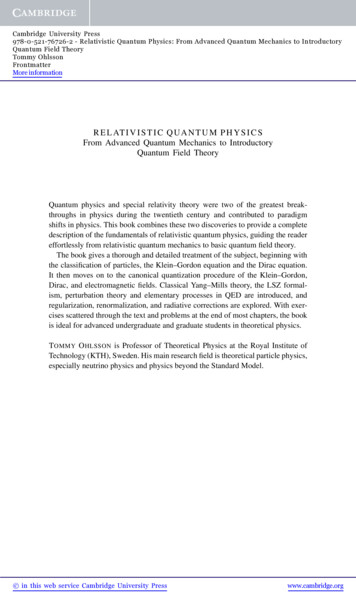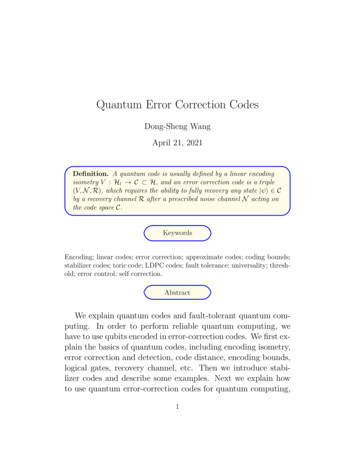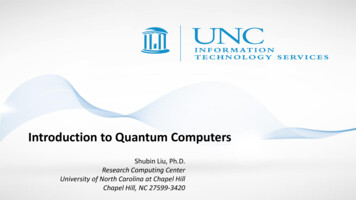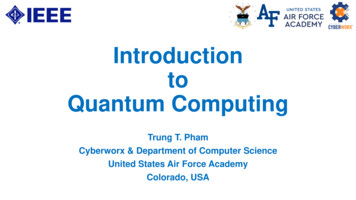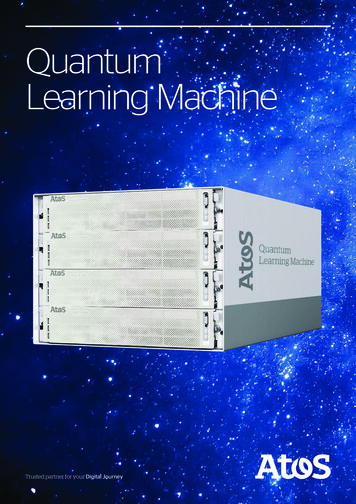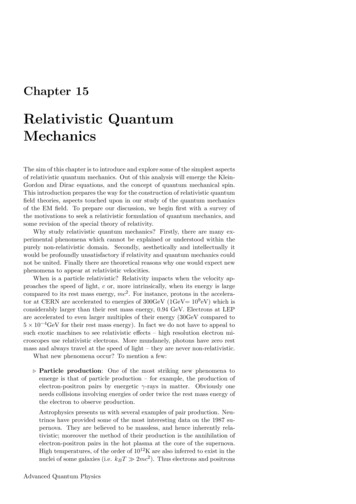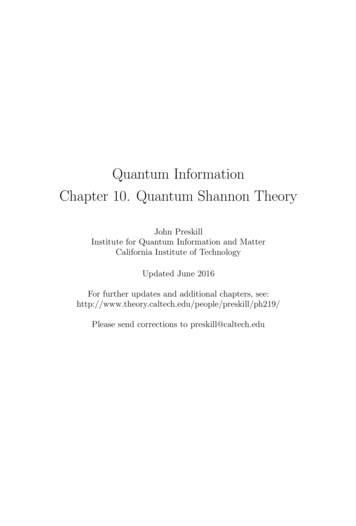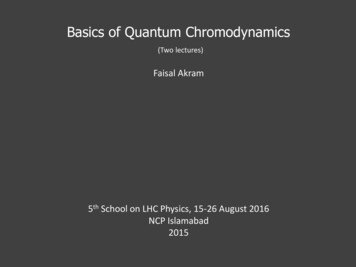
Transcription
Basics of Quantum Chromodynamics(Two lectures)Faisal Akram5th School on LHC Physics, 15-26 August 2016NCP Islamabad2015
Outlines A brief introduction of QCDClassical QCD LagrangianQuantizationGreen functions of QCD and SDE’s Perturbative QCDPerturbative calculation of QCD Green functionsFeynman Rules of QCDRenormalizationRunning of QCD coupling (Asymptotic freedom)Non-Perturbative QCDConfinementQCD phase transitionDynamical breaking of chiral symmetry
Elementary Particle Physics TodayElementary particles:QuarksLeptons(can interact throughstrong interaction)(cannot interact throughstrong �𝑣𝑒𝑒𝑣𝜇𝜇𝑣𝜏𝜏Gauge Bosons:Higgs Bosons: Gauge BosonsHiggs Boson(mediate interactions)Hadrons:(impart mass to the elementaryparticles)Meson: 𝑠 0,1,2 1 3Baryons: 𝑠 , , 2 2Meson:Baryon𝛾, 𝑊 , 𝑍 0 , and 8 gluons𝐻 (God/Mother particle)399 Mesons, 574 Baryons have been discoveredStrong interaction (Quantum Chromodynamics)Electro-weak interaction (Quantum electro-flavor dynamics)The Standard ModelExplaining the properties of the Hadrons in terms of QCD’s fundamental degreesof freedom is the Problem laying at the forefront of Hadronic physics.
How these elementary particles and the SM is discovered?1. Scattering Experiments2. Decay Processes3. Study of bound statesCross sections, Decay Constants,Masses, Spin , Couplings, Form factors, etc.ParticleAcceleratorsand detectorsModelsParticle PhysicsPhenomenologistExperimentalParticle PhysicistMeasured values ofphysical observablesModels Theoretical ParticlePhysicistCalculated values ofphysical observablesIt doesn’t matter how beautifull your theory is,It doesn’t matter how smart you are. If it doesn’tagree with experiment, it’s wrong R.P. FeynmannIt is more important to have beautyin one's equations than to havethem fit experiment. P.A.M DiracDecades of observation and calculations show that the Standard Model of particle physicscan describe almost every thing which we have observed in the labs of high energy physics.
A Quick review of QFT’s The standard model is a quantum field theory. In field theories, fields (defined by field functions) act as fundamental dof of the system. To every different kind of a particle we associate a field.(e.g., electron field, proton field, photon field etc) Particles appear as quanta of field.Quanta of field has particle properties.Quantization𝜙(𝑥) Equation of motion of the fields(𝑠 0)Free Scalar Field:( 𝜇 𝜇 𝑚2 )𝜙(𝑥) 0ℒ0 𝜇 𝜙 † 𝜇 𝜙 𝑚2 𝜙 † 𝜙(𝑠 1/2)Free Dirac Field:𝑖𝛾 𝜇 𝜇 𝑚 𝜓(𝑥) 0ℒ0 𝑖 𝜓𝛾 𝜇 𝜇 𝜓 𝑚𝜓𝜓(𝑠 1)(𝑠 1)Free abelian Vector Field: 𝜇 𝜇 𝐴𝜈 𝜈 ( 𝜇 𝐴𝜇 ) 01ℒ0 𝐹𝜇𝜈 𝐹𝜇𝜈4𝐹𝜇𝜈 𝜇 𝐴𝜈 𝜈 𝐴𝜇Fee Non-abelian Vector Field:1𝜇𝜈ℒ0 𝐹𝜇𝜈𝑎 𝐹𝑎4𝜇𝜈𝜇𝜇𝐹𝑎 𝜇 𝐴𝜈𝑎 𝜈 𝐴𝑎 𝑔0 𝑓𝑎𝑏𝑐 𝐴𝑏 𝐴𝜈𝑐
A Quick review of QFT’s Interaction is introduced by the coupling of fields .For example: ℒ𝐼 𝑒 𝜓𝛾 𝜇 𝜓𝐴𝜇 for QED𝜓𝛾𝜓 Only Lorentz invariant couplings are allowed.ℒ𝐼 𝜓𝛾 𝜇 𝜓𝐴𝜇 ; 𝜓𝛾 𝜇 𝛾 5 𝜓𝐴𝜇 ; 𝜓𝜓𝜙; 𝜓𝛾 5 𝜓𝜙; 𝜓𝛾 𝜇 𝜓𝜓𝛾𝜇 𝜓; . . . . In gauge theories coupling are further constrained bythe gauge symmetries.i) 𝑆𝑈 2 𝐿 𝑈(1)𝑌 for electroweak interaction.ii) 𝑆𝑈(3)𝑐 for strong interaction.
Quantum Chromo Dynamics (QCD)(Foundations) QCD is the theory of strong interaction of quarks, which is based on SU(3)c color symmetry. It assumes each flavor of quark comes in three different colors. The color states of quarks are SU(3) triplets.𝑞𝑞𝑞𝑅𝐺𝐵Quark Fields:𝑓𝜓𝐶𝑓 1,2,3 𝑁𝑓𝐶 𝑅, 𝐺, 𝐵𝑁𝑓 6Free Lagrangian of the Quarks:𝑁𝑓𝑓𝑓𝑓𝜓𝐶 𝑖𝛾 𝜇 𝜇 𝑚0 𝜓𝐶ℒ0 𝑓 1 𝐶 𝑅,𝐺,𝐵The color states of quarks are SU(3)c triplets.𝑁𝑓𝑓𝜓𝑅𝑓𝜓 𝑓𝜓𝐺𝑓𝜓𝐵𝑓𝜓 𝑓 𝑖𝛾 𝜇 𝜇 𝑚0 𝜓 𝑓ℒ0 f e i t a af𝑓 1Where 𝑡 𝑎 are Gell-Mann matrices.This Lagrangian is invariant underglobal SU(3)c gauge transformation.[t a , tb ] if abc tcFree and Classical QCD Lagrangian
Quantum Chromo Dynamics (QCD)(Foundations) Extending the global gauge symmetry to local symmetry.Local gauge transformation: f e i f U a ( x )tafFree Lagrangian does not possess local symmetry:𝑓𝜇𝑓ℒ0 𝜓 𝑖𝛾 𝜇 𝜓 𝑓𝑚0 𝜓 𝑓 𝜓 𝑓 U i ( f U f ff a)t aU fGlobal gauge transformationLocal gauge transformation D ig 0t a Aa ( x)fSuch that D U D t a Aa Ut a Aa U 1 f i U U 1g0𝑓ℒ 𝜓 𝑓 𝑖𝛾 𝜇 𝐷𝜇 𝜓 𝑓 𝑚0 𝜓 𝑓 𝜓 𝑓𝑓ℒ 𝜓 𝑓 𝑖𝛾 𝜇 𝜇 𝜓 𝑓 𝑚0 𝜓 𝑓 𝜓 𝑓 𝑔0 𝜓 𝑓 𝛾 𝜇 𝑡𝑎 𝜓 𝑓 𝐴𝑎𝜇[t a , tb ] if abc tcIncluding kinetic energy term of gauge fields1𝑓𝜇𝜈ℒ 𝜓 𝑓 𝑖𝛾 𝜇 𝜇 𝜓 𝑓 𝑚0 𝜓 𝑓 𝜓 𝑓 𝑔0 𝜓 𝑓 𝛾 𝜇 𝑡𝑎 𝜓 𝑓 𝐴𝑎𝜇 𝐹𝑎𝜇𝜈 𝐹𝑎4𝜇𝜈𝜇𝜇where, 𝐹𝑎 𝜇 𝐴𝜈𝑎 𝜈 𝐴𝑎 𝑔0 𝑓𝑎𝑏𝑐 𝐴𝑏 𝐴𝜈𝑐 , (𝑎 1, 2, . . . , 8)26 fields (6 flavors x 3 Color) (8 gauge bosons); 7 parameter 6 masses 1 couplingThis complete Lagrangian is invariant under local SU(3)c gauge transformation.
Quantum Chromo Dynamics (QCD)(Foundations)Interacting Classical QCD Lagrangian:1𝑓𝜇𝜈ℒ 𝜓 𝑓 𝑖𝛾 𝜇 𝜇 𝜓 𝑓 𝑚0 𝜓 𝑓 𝜓 𝑓 𝑔0 𝜓 𝑓 𝛾 𝜇 𝑡𝑎 𝜓 𝑓 𝐴𝑎𝜇 𝐹𝜇𝜈𝑎 𝐹𝑎4𝜇𝜈where, 𝐹𝑎 𝜇𝜇 𝜇 𝐴𝜈𝑎 𝜈 𝐴𝑎 𝑔0 𝑓𝑎𝑏𝑐 𝐴𝑏 𝐴𝜈𝑐 , (𝑎 1, 2, . . . , 8)111Fa Fa ( Aa Aa )( A a Aa ) g 0 f abc ( Aa Aa ) Ab Ac 442g2 0 f abc f ab 'c ' Ab Ac Ab ' Ac ' .4Quark-gluon interaction3-point gluon interaction4-point gluon interaction
Quantum Chromo Dynamics (QCD)(Quantization)Green Functions of QFTCross sectionsDecay constantsBound State massesCouplingsForm factors𝐺 𝑥1 , 𝑥2 , , 𝑥𝑛 Ω 𝑇 𝜙 𝑥1 𝜙 𝑥2 𝜙 𝑥𝑛𝐺 𝑥1 , 𝑥2 , , 𝑥𝑛 1 𝑖𝛿 𝑖𝛿.𝑍(0) 𝛿𝐽(𝑥1 ) 𝛿𝐽(𝑥2 )Generating function: 𝑍(𝐽) Generating function of QCD:Z ( , , J ) d [ A ]e i dx 4 ( LQCD f f f f J a A a )The path integration over gauge fields diverges due tointegrating over gauge equivalent configurations.A a ( x) A a ( x) 1 ab bD ( x)g0Fixing the gauge means choosing one configurationout of gauge equivalent configurations.lim 𝑖𝛿𝑥𝑛𝑍(𝐽)𝑑𝜙𝑒 𝑖 𝑇 𝑑𝑡 ℒ 𝐽(𝑥)𝜙(𝑥). . . 𝛿𝐽𝑡 (1 𝑖𝜖)Ω𝑇𝐽 0
Quantum Chromo Dynamics (QCD)(Quantization)Gauge fixing impliesZ ( , , J , , ) d [ A ]e i dx 4 ( LQCD LGF LFPG f f f A a J a a a a a )LGF 1( Aa ) 2 ;2 0Not gauge invariant dueto gauge fixing.LFPG ( a ) a g 0 f abc ( a ) b A cThe generating function Z must be gauge invariant because gauge transformation amounts toredefine the variables integration.This trivial requirement of Gauge invariance of the generating function translates intonon-trivial identities which all Green functions carrying gauge field(s) must satisfy.QED:Wards-Green-Takahashi identities (WGTI) 1q D q2 0QCD:Slavnov Taylor identities (STI) 1q D q 1 1iq (k , p ) S (k ) S ( p )q2 0q iq (k , p )(1 b(k 2 )) (1 B(k , p )) S 1 (k ) S 1 ( p )(1 B(k , p ))
Green Functions of QCD2-point Green functions:Ω 𝑇 𝜓(𝑥1 ), 𝜓(𝑥2 ) Ω Ω 𝑇 (𝐴𝜇𝑎 (𝑥1 ), 𝐴𝑏𝜐 (𝑥2 ) Ω Ω 𝑇 (𝑐 𝑎 (𝑥1 ), 𝑐 𝑏 (𝑥2 ) Ω 3-Point Green functions:4-Point Green functions:
Schwinger-Dyson Equations (SDEs) of QCD In QFT the Green functions satisfy a set of exact mathematical equations called SDEs. Corresponding to each green function we have a SDE. These are exact equations and can be used to find Green functions perturbativelyas well as non-perturbatively.
Schwinger-Dyson Equations of QCDSDE of Quark Propagator:Non Perturbative Truncation:One or more Green functions aremodeled subjecting to somegeneral field theoretical constraints.OrUsing the results obtained from lQCD.SDE of Gluon Propagator: 5 termsSDE of quark-gluon vertex: 7 termsPerturbative Truncation:𝑁𝑓
Feynman Rules of QCDQCD full Lagrangian:11LB i f f m f f f g 0 f t a f Aa ( x) Fa Fa ( A a ) 242 0 0a 0a g 0 f abc 0a 0b A0c Where, 111Fa Fa ( Aa Aa )( A a Aa ) g 0 f abc ( Aa Aa ) Ab Ac 4422g 0 f abc f ab 'c ' Ab Ac Ab ' Ac ' .4Vertices:ig 0 tija g 0 f abc [( p q ) g (q k ) g (k p ) g ] g 0 f cab p f abe f cde ( g g g g ) f abe f cde ( g g g g )}Propgators:1k m i 1abFree gluon propagator : D (q ) ab 2q i Free Quark propagator : Sij (k ) ijFree ghost propagator : Gab (k ) abig 02 { f abe f cde ( g g g g )1k 2 i q q g 2q q q 2 02 q i q
Color Algebra:t t C F ij ,a aik kjTr (t a t b ) TF ab ,N c2 1 4CF 2Nc3TF f acd f bcd C A ab ,12CA Nc 3
Leading order QCD green functionsQuark propagator:dk 4 21S ( p ) ( p m0 ) iC F g 0 D0 (k ) 4(2 )p k m0 i 0 1(𝑘 ) 𝑘 3 𝑑𝑘0 𝑘3(Linearly divergent)Gluon propagator: 11D (q ) D0 (q ) (quark) (gluon) (ghost) dk D 4 D 211 iTF gTr( ),0 (2 ) Dk m0fq k m0ff C i A2 dk 4 2 k (k q ) iC A g0 2(2 ) 4k (k q) 2quarkgluonghost (2k q ) g (k q ) g (2q k ) g dk 4 2 (2 ) 4 g 0 D0 (k ) D0 (q k ) (2k q) g (k q) g (2q k ) g 𝑘0 𝑑𝑘 (Quadratically divergent)
Quark gluon vertex (1PI): 𝑑𝑘 /𝑘0(Logarithm divergent)If theory is renormalizable then at any order of perturbation, all the divergences can beabsorbed by redefinitions of the coupling and fields.Redefinitions of coupling and fields are made through multiplicative constants calledrenormalization constants. 0fc ( x) Z F1/ 2 cf ( x), 0fc ( x) Z F1/ 2 c f ( x),A0a ( x) Z B1/ 2 A a ( x), 0 a ( x) Z 1/ 2 a ( x), 0 a ( x) Z 1/ 2 a ( x),g 0 Z g g , m0f Z m , f m f ,1 0 Z Gauge invariance which is expressed in terms of STI’s enforce thati) All quarks are renormalized by same constant 𝑍𝐹 .ii) All gluons are renormalized by same constant 𝑍𝐵 .iii) All ghost are also renormalized by same constant 𝑍𝜔 .
End of Lecture 1Summery: In QCD we have 5 different interactionsi) Quark-Gluon interactionii) 3 Gluon interactioniii) 4 Gluon interactioniv) Ghost-Gluon interaction QCD green functions satisfy SDE’s which are exact but unsolvable unless truncated. In perturbative truncation the amplitude of QCD green functions can be writtendirectly from the Feynman diagram using Feynman rules. Naïve analysis show that these Green function carry ultraviolet divergences. Since QCD in renormalizable, therefore, the divergences can be absorbed by redefinitioncoupling and field of QCD.Next Lecture: We will continue renormalization program in QCD using dimensional regularization. Discuss some non-perturbative aspects of QCD.
Procedure of Renormalization: Regularize the field theory.(i.e., to modify it temporarily in such way that all divergent integrals become finite)i) Dimensional regularization4 D 4 dk D v04 Ddk 4dk D (2 ) 4 (2 ) D (2 ) D(breaks only scale invariance)ii) Pauli-Villars regularization111 2 2k i0k i 0 k 2 i 02(breaks Hermicity and gauge invariance in non-Abelian gauge theories)iii) Lattice regularizationcontinuous space-time is replace by discrete Lattice of space-time.Lattice spacing acts as regularizing parameter.(breaks Poincaré invariance)
S 1 ( p ) ( p m0 ) ( p )dk D v04 D 21 ( p ) iC F gD(k) 00 (2 ) Dp k m0 i 0 ( p ) ( p m0f ) A( p 2 ) m0f B( p 2 )g 02 2 2 A( p ) C F log4 1 2I(p) 116 2 2g 02B( p ) CF16 22 2 2 3 log 4 1 2 I 2 ( p ) xm 2 x(1 x) p 2 I1 ( p ) (1 x) log v02 012 xm 2 x(1 x) p 2 I 2 ( p ) (1 x) log v02 012
11D (q ) D0 (q ) (quark) (gluon) (ghost) 2N f 2g 02 22 (q ) 2TF( gq qq) log4 4I(q) 316 2 3 g 02 C A16 2 19 2 11 2 1 22 22 log 4 I 4 (q ) g q log 4 I 5 (q ) q q 2 3 3 6 g 02 C A32 2 1 2 1 2 1 2 22 log 4 I 6 (q ) g q log 4 2 I 6 (q ) q q 6 3 6 quarkgluonghost 1q D q2 0gluonThe Π𝜇𝜈 gluonq 0q ghostand Π𝜇𝜈ghostdo not satisfy the condition of transversality. 10 2 g 02 62 10 C A( g q 2 q q ) log 4 log(q 2 ) 232 3 9 3 2all2 all ( g q q q ) ( q )g 02 (q ) 16 2all2 4 N f 10 2 31 5 C A log 4 C A log q 2 8TF I 3 (q 2 ) TF36 9 3
ig 0 a ( p, p ) ig 0t a ig 0 ( 1) a ( p, p ) ig 0 ( 2 ) a ( p, p )3 3 2 a g0ig 0 3 i C At log 4 (Finit Part)2 2 16 g 03 2 ( 2) aaig 0 C A / 2 C F t i log4 (Finit Part) 216 (1) ag 03 2 ig 0 (C A C F ) i log4 (Finit Part)2 16 a
Renormalization: 0fc ( x) Z F1/ 2 cf ( x), 0fc ( x) Z F1/ 2 c f ( x),A0a ( x) Z B1/ 2 A a ( x), 0 a ( x) Z 1/ 2 a ( x), 0 a ( x) Z 1/ 2 a ( x),g 0 Z g g , m0f Z m , f m f ,1 0 Z 1. Multiplicative Renormalization Strategy: S ( p ) Z F 1S ( p ) D (q ) Z B 1 D (q ) ( p, p ) ZgZ F Z B1/ 2 ( p, p )
2. Counter terms Strategy:11LB i 0f 0f m0f 0f 0f g 0 0f t a 0f A0 a ( x) F0 a F0 ( A a ) 2a42 0 0a 0a g 0 f abc 0a 0b A0c LB Z F i f f m f Z m , f Z F f f gZ g Z F Z B1/ 2 f t a f Aa ( x) Z B Z a 2ZBFa Fa ( A )42 Z a a g Z g Z Z 1A/ 2 f abc a b A cZ F 1 Z F , Z B 1 Z B , Z g 1 Z gLB i f f m f f f g f t a f Aa ( x) 11 a 2Fa Fa ( A )42 a a g f abc a b A c Z F i f f ( Z F m0f m f ) f f ( Z g Z F Z B1/ 2 1) g f t a f Aa ( x) Z a a ( Z g Z Z 1A/ 2 1) g f abc a b A c Z BFa Fa 4
Renormalization Schemes: S ( p ) Z F 1S ( p ) D (q ) Z B 1 D (q ) ( p, p ) ZgZ F Z B1/ 2 ( p, p )A renormalization constant Z:Z (divergent part) (finte part) The divergent part is chosen in such a way that it cancelsthe pole in un-renormalized Green function. Each different way of choosing the finite part defines adifferent renormalization scheme.Minimal subtraction (MS) scheme:The renormalization constants only cancel the divergent parts of the Green functionswithout affecting their finite part.Modified Minimal subtraction (MS) scheme:The renormalization constant also cancel a finite part in the Green functionN 2 log 4 These renormalization schemes are called mass independent renormalization schemes.The results of perturbative calculations are scheme dependent.
Renormalization constants of QCD in MS at 1 loop order:g2Z F 1 CFN 16 2g2Z m 1 3C FN 16 2g2 54ZB 1 C TR N f A16 2 33g 2 112Zg 1 C TR N f A16 2 63Renormalized gluon propagatorat 1 loop order: 11D (q ) D0 (q ) (all) N N q q q 2 q q D (q ) q g 2 q q2 2all2 all ( q ) q g q q ( q ) 10 S 1 ( p ) ( p m f ) ( p ) ( p ) ( p m f ) A( p 2 ) m f B( p 2 )A( p ) C Fg2216 g2B( p 2 ) CF 1 2I ( p ) 2216 1 1 2I ( p ) 2221 A( p 2 )S ( p) p m f 1 B( p 2 ) g 02 (q ) 16 2allRenormalized quark propagatorat 1 loop order:22D (q ) 31 52 2 C A log q 8TF I 3 (q ) 9 3 q q 1 g q 2 1 all (q 2 ) q2 q q 2 2 q q
Scale dependence in QCD: Dimensional regularization necessitate the introduction of a scale parameter 𝜈0 .S D ( p, v0 ), DD (q, v0 ), D ( p, p , v0 ) This dependence on 𝜈0 can easily be removed by redefining the renormalizationconstants Z’s.dk D v0 dk 4 (2 ) 4 (2 ) D v Z (v) Z v0 v02 N log 4 log 2 v 2 S ( p, v) Z F 1 (v, v0 ) S D ( p, v0 ) D (q, v ) Z B 1 (v, v0 ) DD (q, v0 ) ( p, p , v) Z g (v, v0 )Z F (v, v0 ) Z B1/ 2 (v, v0 ) D ( p, p , v0 ) Renormalized green functions are now function of arbitrary scale parameter 𝜈. However, the physical observables must not depend upon the choice of 𝜈. This is ensured bya correct 𝜈 dependence of fundament constants (m’s and g’s) of the field theory.𝐴 𝑜𝑏𝑠. 𝐴 𝑚 𝜈 , 𝑔 𝜈 , gre. fun. 𝜈
Running coupling of QEDThe running of QCD coupling:Z g (v ) g (v ) g 0Taking the derivative w.r.t log(𝜈). Z g log vg (v ) Z g ( g ) Z g 1 g 0 log v1 g (g)g log v Z g log vQCD is asymptotically freeg 2 112 Z g (v ) 1 C TN ARf N 16 2 63 g 2 114 (g) C TN AFf 16 2 33 1 gg2 0g log v16 2 s s 0 log v2 N 0 v2 log 4 log 02 v 2114C A TF N f33g (v ) 2 s (v ) 4 2 s (Q ) 2 s (v 2 )1 s (v 2 ) 0 log(Q 2 / v 2 ) /(4 )
END of Lecture 1Lecture 2 (non-perturbative QCD)
Quantum Chromodynamics(Non-perturbative aspects)Lecture 2Faisal AkramInternational Symposium on Physics Beyond the Standard ModelNCP Islamabad2015
Outlines Characteristics of QCDAsymptotic freedomConfinementQCD phase transitionDynamical breaking of chiral symmetry Non-Perturbative truncation of Schwinger-Dyson equations Models of quarks-gluon vertex and gluon propagator Numerical Solution of SDE of quarks propagator Results and comparison with the experiments
Characteristics of QCD Asymptotic freedom Quarks Confinement QCD phase transition Dynamical Breaking of Chiral SymmetryQ2 s ( s ) log Q 2 ( s ) s 0 O(2)4 where 0 (33 2 N f ) / 3𝑁𝑓 16.5 (Asymptotic freedom)* D. J Cross and F. Wilczek, PRL. 30, 1343 (1973); H. D. Politzer, PRL 30, 1346 (1973).
Characteristics of QCD Asymptotic freedom Quarks confinement QCD phase transition Dynamical Breaking of Chiral Symmetry𝐹 𝑉 𝑏 𝑟* K.J. Juge, J. Kuti, and C. Morningstar, Phys. Rev. Lett. 90, 161601 (2003).𝑉(𝑟)𝑉 𝑟 𝑏𝑟
QCD phase transitionConfined State of MatterDe-Confined State of MatterQGP is expected to produce at Tc 170 MeV 2 x 1012 K 130,000 T and 0Theoretical EvidenceEvidence of QGP? HG 3I 230T47 QGP 2 f 2 s 2 q 3c 2 s 8c T 4 37 T 4830 3022So far no conclusiveexperimental proof.
Quantum Chromo-dynamics Asymptotic Freedom Quarks confinement QCD phase transition Dynamical Breaking of Chiral Symmetry(2008 Nobel Prize)Current mass: 𝑚𝑢/𝑑 3 6 MeVSelf interaction of quarks𝑀𝑝 939 MeVConstituent mass: 𝑚𝑢/𝑑 350 MeVudscbCurrent mass(MeV)3610011004200Constituentmass (MeV)35035053015004600
Dynamical Breaking of Chiral Symmetry in QCDFermionic part of QCD Lagrangian for light quarks:L iqi D qi mi qi qi i u, d , sFree quark propagator: 1ip mThis Lagrangian is invariant under SU(3)L SU(3)Rsymmetry if the current masses of light quarksare zero.Pole mass𝑚𝑢/𝑑 3.7MeVMass function(dynamical mass)Full propagator:F ( p2 )ip M ( p 2 )𝑀 𝑝2 Pole mass,𝑀𝑢/𝑑 390MeV𝑚𝑢/𝑑 3.7MeVPerturbativeexpansionM ( p2 ) m 1 22 ln p / QCD 2 mIf the current mass m 0 then M(p2) 0Schwinger-Dyson equations (A non-perturbative technique)2 2 mWhere, p2 Λ2QCD 0.2 GeV M ( p ) 32What if, p2 Λ2QCD? m 4 / 0 0 11N c 2 N f3𝑝2 qq 0 1 p 2 ln p 2 / 2QCD 2 1 mRenormalization point independentQuark condensate q q 0 (0.241) 3 GeV 3Non-zero value of M(p2) even when m 0 means chiral symmetryis dynamically broken.
Green Functions of QCD2-point Green functions:Ω 𝑇 𝜓(𝑥1 ), 𝜓(𝑥2 ) Ω Ω 𝑇 (𝐴𝜇𝑎 (𝑥1 ), 𝐴𝑏𝜐 (𝑥2 ) Ω Ω 𝑇 (𝑐 𝑎 (𝑥1 ), 𝑐 𝑏 (𝑥2 ) Ω 3-Point Green functions:4-Point Green functions:
Schwinger-Dyson Equations of QCDSDE of Quark Propagator:SDE of Gluon Propagator:𝑁𝑓 5 termsSDE of quark-gluon vertex: 7 termsPerturbative Truncation:𝑁𝑓Non Perturbative Truncation:One or more green functions aremodeled subjecting to somegeneral field theoretical constraints.OrUsing the results obtained from lQCD.
Green Functions of QCD (continued)𝑘Quark Propagator:Free Quark Propagator:F (k 2 )1S (k ) 22ik M (k ) ik A(k ) B(k 2 )S 0 (k ) 𝑘1ik m𝑞Free Gluon Propagator:Gluon Propagator: 1 qq qq L0 q2 q1 q q D ((qq)) DD((qq ) 2 22 D 2(q ) 2 2 2Dq qq q q q qT 1q D q2 022q D (q ) In covariant gauge Green functions are functionof arbitrary gauge fixing parameter 𝜉.𝑆 𝑘, 𝜉 , 𝐷𝜇𝜈 𝑞, 𝜉 , Γ𝜇 (𝑘, 𝑝; 𝜉) A necessary condition that physical observablewill not depend upon the choice of 𝜉 is that allWGTI/STI’s should be satisfied.Quark-Gluon Vertex:ig 02 0 q q 2 2 q qWGTI of gluon propagator implies 𝐷𝐿 𝑞2 𝜉0𝑝 a1 q q q 2 q2 (k , p )𝑘12 (k , p ) Pi (k 2 , p 2 , k p )Vi (k , p )i 1𝑖𝑞𝜇 Γ𝜇 𝑆 1 𝑘 𝑆 1 𝑝WGTI of quark gluon vertex
SDE of Quark Propagator:dk 4 2 a a aS ( p ) (i p m0 ) g 0 D (q ) S (k ) (k , p )(2 ) 422 1To solve the SDE of quark propagator we require the knowledgeof full gluon propagator and quark-gluon vertex.We model gluon propagator and quark-gluon vertex subjectingto some general field theoretical constraints or using results fromlQCD.Field Theoretical Constraints: What necessary and sufficient knowledge ofgluon propagator and quark-gluon vertex isrequired in order to describe the completeand correct behavior of quark propagator?Gauge Invariance (WGTI’s or STI’s).Gauge covariant relations.Multiplicative renormalizability.Agreement with perturbation theory in weak coupling limit. The model should also agree with lQCD in construction as well as in its implications. Phenomenological agreement is an ultimate condition.
Models of Quark-gluon Vertex1. Replacing by free vertex (k , p ) Rainbow TruncationThis model breaks WGTI/STI of quark gluon vertex.𝑖𝑞𝜇 Γ𝜇 𝑆 1 𝑘 𝑆 1 𝑝Constraint on the vertex due to WGTI:12 (k , p ) L (k , p ) T (k , p ) Pi (k 2 , p 2 , k p)Vi (k , p)i 1𝑖𝑞𝜇 Γ𝜇𝐿 𝑆 1 𝑘 𝑆 1 𝑝𝑞𝜇 Γ𝜇𝑇 0 A(k 2 ) A( p 2 ) A(k 2 ) A( p 2 ) (k p ) (k p )2k 2 p22 L B(k 2 ) B( p 2 ) (k p ) k 2 p2 Longitudinal part is called Ball Chiu (BC) part.8 i (k 2 , p 2 , k p )Ti Ti 1Multiplicative renormalizability of SDEcan be used to constrain Γ𝜇𝑇 (𝑘, 𝑝)
Renormalization of SDE of quark propagatorSDE of Quark Propagator:The MR requires that all Green functions should berenormalizable by using finite number of multiplicativerenormalization constant.The condition of MR cannot be satisfied by any arbitrarydk 4 2 a aS ( p ) (i p m0 ) g 0 D (q ) S (k ) quark-gluon (k , p ) vertex ansatz in SDEs.(2 ) 422 1How to do renormalization:Regularize the theory byapplying hard momentumcutoff. 1/2S ( p; )D (q; ) (k , p; )𝜓 𝑍2 𝜓0 1/2𝐴𝜇𝑎 𝑍3 𝐴𝑎0𝜇1/2𝑍2 𝑍3𝑔 𝑍1𝑔0 S ( p; ) Z 2 1 ( , ) S ( p; ) D (q; ) Z 3 1 ( , ) D (q; ) (k , p; ) Z1 ( , ) (k , p; ) Renormalized green functions are function of arbitrary scale parameter 𝜇. However, the physical observables must not depend upon the choice of 𝜇. This is ensured bya correct 𝜇 dependence of fundament constants (m’s and g’s) of the field theory.𝐴 𝑜𝑏𝑠. 𝐴 𝑚 𝜇 , 𝑔 𝜇 , gre. fun. 𝜇dk 4 2 a a 1S ( p ) Z 2 (i p m0 ) Z1 g D (q ) S (k ) (k , p )(2 ) 42
Multiplicative RenormalizabilityThe condition of MR cannot be satisfied by any arbitrary quark-gluon vertex ansatz in SDEs.(An example)Quark renormalization function in leading-logarithm approximation:F (k 2 )S (k ) ik M (k 2 )F ( p 2 ) 1 A1,1 ln( p 2 / 2 ) 2 A2, 2 ln 2 ( p 2 / 2 ) 2MR requires that 𝐴2,2 𝐴1,1/1!If we use bare approximation of quark-gluon vertex in quark propagator SDE we getp 222 1 k222 p2 1 dkF(k) dkF(k) k2 (where 𝑀 𝑝2 is taken zero as an approximation)F ( p2 )4 p 2 0p2p2 23 2 2 2 22F ( p ) 1 ln( p / ) ln ( p / ) 4 24 2232In which 𝐴2,2 2 𝐴1,1/1!MR can be used to constrain Γ𝜇𝑇 (𝑘, 𝑝)as the BC vertex itself doesn’t satisfythe condition of MR.
Models of Quark Gluon Vertices2. Curtis Pennington (CP) Vertex: (k , p ) BC (k , p ) T 61A(k 2 ) A( p 2 )2d (k , p)CP vertex satisfies the condition of MR in quench approximation for zero as wellas non-zero quark mass.3. Kizilersu Pennington (KP) Vertex: (k , p ) BC (k , p ) 2 T ii 2 , 3, 6 , 8i A(k 2 ) A( p 2 ) 41112222 ,A(k) A(p) A(k) A(p)ln3 (k 4 p 4 )3 (k 2 p 2 ) 2A(q 2 ) A(k 2 ) A( p 2 ) 51112222 ,A(k) A(p) A(k) A(p)ln12 (k 2 p 2 )6 (k 2 p 2 )A(q 2 ) 11 6 A(k 2 ) A( p 2 ) ,224 (k p ) 8 0. 3 KP vertex satisfies the condition of MR in un-quenched approximation only for zero quark mass.
Models of gluon propagatorSDE of Quark Propagator:Rainbow Truncation adk 4 2 aS ( p ) Z 2 (i p m0 ) Z1 g D (q ) S (k ) a (k , p )4(2 )2 12 Maris-Tandy Model: It is based on Rainbow truncation of vertex.Gluon propagator:g 2 D (q ) g 2q qD(q 2 ) 2 2q qg 2 D(q 2 )lim ?2q 2 2QCDq (in Landau gauge) m g 2 D(q 2 )1lim2 4 2222q QCDqln[q / QCD ] q 2(Perturbative calculation) m g 2 D(q 2 ) 4 21 e q / 4 mt2 q 2 / 2 6 Dq e 4 q2 1 / 2 ln[ (1 q 2 / 2QCD ) 2 ]q22Infrared dominant; A Model2Maris-Tandy ModelMT modelUV dominant; Given by perturbative QCD𝜔 0.4 so that the first term don’t perturb with 2nd in UV region.𝐷 0.93 GeV2 is fitted to lQCD result of quark condensate , 𝑞𝑞 𝜇 1 𝐺𝑒𝑉 0.241 3 GeV3.This model does not include any Nf dependence in the infrared part.Perturbative
Solution of SDE of quark propagator in Rainbow truncation MT modelq q a4dk 4 g 2 D(q 2 )S ( p ) Z 2 (i p m0 ) Z1 ( 2 ) S (k ) 423(2 )qq2 1 We need to first fix the renormalization constants Z1 and Z2.𝑍2 𝑍1 (WGTI of quark-gluon vertex) On-mass shell renormalization scheme.Renormalization BC:S ( p) p 2 2 1i p m F ( p2 )S ( p) i p M ( p 2 )Renormalized current massF ( p 2 ) p 2 2 1,M ( p 2 ) p 2 2 m 22 11F (k 2 )2(k q )( p q ) 4 g D(q ) Z1 dkk p 2 12 4 p 2 F ( p2 )q2k 2 M 2 (k 2 ) q2 2222 M ( p2 )14 g D(q ) M (k ) F (k ) Zm dk 204 2222 F ( p2 )4 qk M(k) 0 122 1F (k 2 )2(k q )( p q ) 4 g D(q ) Z2 1 dkk p 2222 2 12 4 p 2 qk M(k)q p2 2 2222 14 g D(q ) M (k ) F (k )m Z 2 m0 4 dk 4 0q2k 2 M 2 (k 2 ) p 2 2
Quark Propagator using MT modelbcsu/d𝑚𝑢/𝑑 0.00374 GeV𝑚𝑠 0.083 GeV𝑚𝑐 0.88 GeV𝑚𝑏 3.8 GeVHow the model generates Dynamical mass?𝜇 19 GeV MT model of gluon propagator function: m g 2 D(q 2 ) 4 21 e q / 4 mt2 q 2 / 2 Dqe 4 q2 61 / 2 ln[ (1 q 2 / 2QCD ) 2 ]q222The 1st term of the MT model enhancethe coupling strength in IR region throughthe controlling parameter D.It is this enhancement which generates dynamicalmass in IR region.Gradual decrease in parameter D shows that DCS isrestored if D 0.261.
Comparison with Qu-lQCD results:Pion form factorhBSE:Ladder TruncationMT model
Quark Mass functions using KP VertexTroubles with MT model: Rainbow truncation breaks Gauge invarianceas the WGTI/STI of quark-gluon is not satisfied.As a result physical observable may developdependence on gauge fixing parameter 𝜉. Γ𝜇 (𝑘, 𝑝) 𝛾𝜇Violates multiplicative renormalizability.As a result physical observable may developdependence on arbitrary scale parameter 𝜇.Kizilersu Pennington (KP) Vertex: (k , p ) BC (k , p ) 2 T ii 2 , 3, 6 , 8i A(k 2 ) A( p 2 ) 41112222 , A(k) A(p) A(k) A(p)ln23 (k 4 p 4 )3 (k 2 p 2 ) 2A(q) A(k 2 ) A( p 2 ) 51112222 A(k ) A( p ) 6 (k 2 p 2 ) A(k ) A( p ) ln A(q 2 ) , 3 12 (k 2 p 2 ) 6 11 A(k 2 ) A( p 2 ) , 8 0.224 (k p )KP vertex satisfies the condition of MR in un-quenched approximation
Critical number of quark flavors in QCD Asymptotic freedom requires that Nf 16.5 (at 1 loop order).Dynamical breaking of chiral symmetry may also require a critical number of quark flavors.SDE of Quark Propagator:MT model does not allow as to study the flavordependence of quark propagator in the infraredregion as the gluon propagator is itself takenFlavor independent.dk 4 2 aS ( p ) Z 2 (i p m0 ) Z1 g D (q ) S (k ) a (k , p )4(2 )2 1Gluon propagator (in Landau gauge 𝜉 0):D(q 2 , N f ) q q D (q, N f ) q 2q2 𝑁𝑓 5 termsFit with Refined Gribov-Zwanziger (RGZ) formz ( 2 )q 2 (q 2 M 2 )D(q , N f ) 4q q 2 M 2 13 g 2 A2 / 24 M 2 m022 m0 ( N f ) 1.011(9.161 N f ) 1/ 2 GeVg 2 A2 ( N f ) 0.474(16.406 N f ) GeVM 2 4.85 GeVA. Ayala, A. Bashir, D. Binosi M. Cristofretti, and J. Rodriguez-Quintro, Phys. Rev. D 86, 074512 (2012)
SDE of Quark Propagator:Solution of SDE of the Quark Propagatordk 4 2 a aS ( p, N f ) Z 2 (i p m0 ) Z1 g D (q, N f ) S (k , N f ) (k , p )(2 ) 422 1General form of quarks propagator:S ( p, N f ) F ( p2 , N f )i p M ( p 2 , N f )Lattice QCDKP Vertex(Current mass 𝑚 0)
Final remarks Asymptotic freedom in QCD requires that 𝑁𝑓 16.5. Latest lattice results of gluon propagator when used in SDE of quark propagatortruncated by KP vertex shows that 𝑁𝑓 7.2 if QCD is to exhibit DCSB.
Extra slides
Elementary Particle Physics TodayElementary particles:QuarksLeptons(can interact throughstrong interaction)(cannot interact throughstrong �𝑣𝑒𝑒𝑣𝜇𝜇𝑣𝜏𝜏Gauge Bosons:Higgs Bosons: Gauge BosonsHiggs Boson(mediate interactions)Hadrons:(impart mass to the elementaryparticles)Meson: 𝑠 0,1,2 1 3Baryons: 𝑠 , , 2 2Meson:Baryon𝛾, 𝑊 , 𝑍 0 , and 8 gluons𝐻 (God/Mother particle)399 Mesons, 574 Baryons have been discoveredStrong interaction (Quantum Chromodynamics)Electro-weak interaction (Quantum electro-flavor dynamics)The Standard ModelExplaining the properties of the Hadrons in terms of QCD’s fundamental degreesof freedom is the Problem laying at the forefront of Hadronic physics.
Elementary Particle Physics1. Scattering Experiments2. Decay Processes3. Study of bound statesCross sections, Decay Constants,Couplings, Form factors, Masses, Spin etcParticleAcceleratorsand detectorsModelsParticle PhysicsPhenomenologistExperimentalParticle PhysicistMeasured values ofphysical observablesModels Theoretical ParticlePhysicistCalculated values ofphysical observablesIt doesn’t matter how beautifull your theor
Particle Physics Phenomenologist Calculated values of physical observables Theoretical Particle Physicist Models Decades of observation and calculations show that the Standard Model of particle physics can describe almost every thing which we have observed in the labs of high energy physics. It is more important to have beauty
